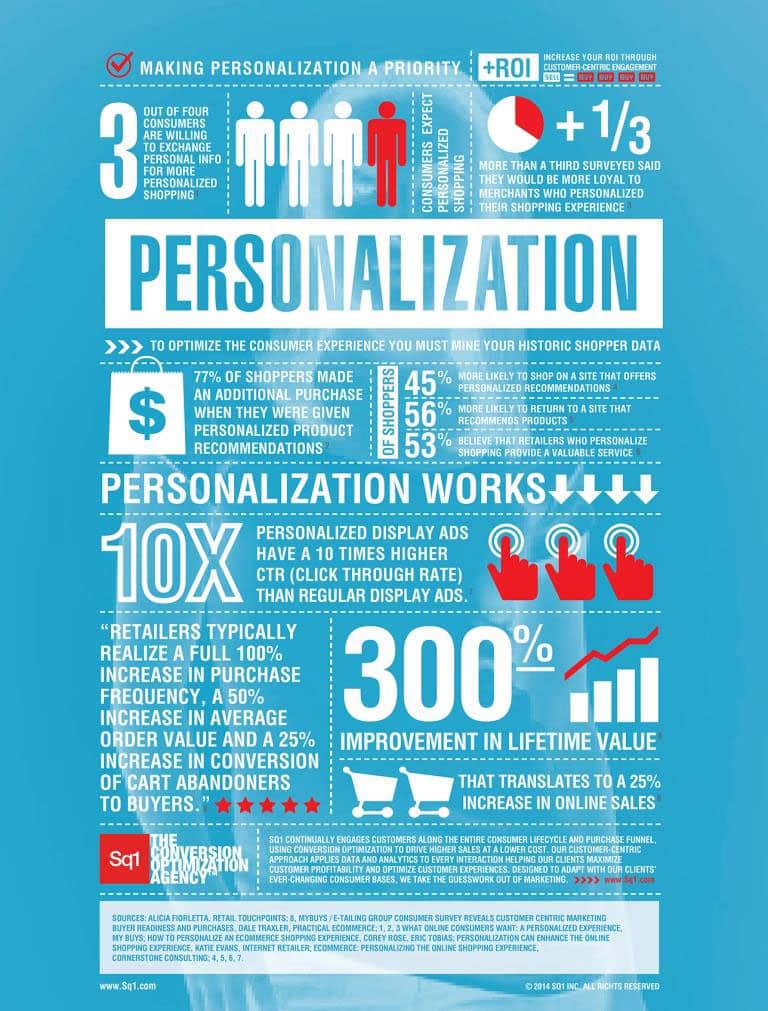Making Personalization a Priority

Increase Your ROI Through Customer-Centric Engagement, with consumers using a myriad of physical and digital channels to browse and buy, marketers need to become more strategic in how they both engage digital shoppers and encourage purchase. When you add the additional layer of being bombarded with messages from competitors and other sources, it’s imperative to cut through the clutter and present the right product, at the right price, at the right time. You need to set yourself apart and stand out so that the consumer chooses your website over any others. And you want them to keep coming back. So the next question is, how do you do this? Implementing a customer-centric approach, while additionally personalizing the consumer experience allows what is presented to be relevant to the individual, which makes them feel important, and appreciated, and understood.
What is personalization?
Dale Traxler, a contributing editor for Practical Ecommerce defines personalization as “presenting information to a consumer that acknowledges whom he is and what his intentions are — to make his interaction more meaningful.”
While many online stores have data on what consumers have purchased and the number of visits, few effectively personalize the shopping experience. Notable exceptions include Amazon and Zappos who far surpass the competition in providing user specific, personalized data. Using the information on previous customer purchase behavior, these companies deliver targeted content and promotions to make the consumer experience more positive and relevant.
Guided search and navigation are also additional examples of personalization. By offering filters to help refine search terms (i.e. brand, price, deals, color and ratings), the consumer can find the product they are interested in much faster.
E-mails provide another avenue of personalization, typically in the solicitation. If the content is customized further, referencing previous purchases, it is even more effective and minimizes the perception that the email is spam.
Personalization is no longer an option; it’s a necessity:
Retailers that embrace and invest in personalization tools and strategies to address consumer expectations and demands are the ones that are going to prove to survive and thrive. By leveraging product recommendations to drive cross- and up-sell opportunities and tailoring offers / messaging based on consumer historical data, marketers are able to build better bridges to consumers. They are able to boost the number of items sold and foster long-term loyalty. The proof is in the numbers. Nearly 60% of marketers experienced increased ROI when they personalized their online store.
Personalization is becoming an increasingly critical component of eCommerce design and redesign. Online retailers that provide a more personalized shopping experience by using tactics such as placing product recommendations strategically on their home page, notice a significant uptick in conversions.
The key to creating this better architecture is leveraging shopper information to help personalize the site design. But it’s more than just paying attention to what shoppers buy, it’s also about looking for data trends that affect purchase such as price points, favored product categories, preferred styles/colors, and brand preferences.
Retailers who know what matters most to the consumer are able to make the right recommendations that can convert into sales. It’s comparable to a personal shopper that keeps a log of customer’s sales and preferences so they call the consumer when a product, brand or style that they like or have bought before is on sale. The consumer feels pampered and appreciates the gesture.
Let your shoppers be your guide:
Discovering what path online shoppers take while browsing through your products pre-purchase can also be very illuminating and helpful to improving your site. By following the way they browse, you can customize which products you show them. Tracking the flow of shoppers can help you personalize their experience and convert browsing into sales.
Sites should be designed to show items that complement what the online purchasers are interested in buying. Not only does this help to personalize the experience, but it also allows you to sell more products.
When your eCommerce site is designed to show complementary items to the product(s) your online shoppers are interested in purchasing, not only does this help to personalize the experience, it also allows the merchant to sell more goods.
Building an online winning personalization strategy:
As with most digital strategies, however, knowing and doing are two very different things. While 61% of online marketers understand the importance of personalizing online shopping, 51% of them are not sure how to do it.15
Sq1 recommends the following tactics be deployed to help with personalization:
- Add meaningful product recommendation to each page
- Send meaningful offers (an IBM study, From Transactions to Relationships found that nearly 90% of shoppers will take the time to complete surveys and other analysis to help stores better understand their needs)16
- Track, record, and use consumer interaction history and data; this is especially important in the areas of product recommendations, offers
- Interact with consumers in real time so you change your website’s presentation to suit the consumer’s current intent
The Aberdeen Group report, Hyper-Connected Online Retail Personalization, mentioned four strategic best practices that successful retailers are using to help with personalization:
1st- Develop product strategies based on deep customer segmentation such as affinities, preferences and demographics
2nd- Coordinating product placement with customer behavior
3rd- Establishing quantifiable methodologies for measuring customer activity
4th- Increasing online ad relevance with search activity
Personalization is a holistic strategy:
Retailers also need to develop a unified strategy that is able to cross channel lines, which integrates the consumer experience and present a singular, relevant message. Retailers must identify customer preferences and trends by examining specific data points, across every touch point. A siloed approach will limit your success as your website does not work in a vacuum. To personalize effectively, retailers must leverage the data they have to predict the types of cross-channel experiences consumers will respond to best and most.
It’s also important to design your personalization strategy not just for today, but long-term. After all, it’s not enough to just get your customers to buy now, you’ve invested heavily in attracting them so you want to retain them and build customer loyalty. By committing to a customer-centric approach, you will not only keep them returning to your site but encourage them to recommend your site to their social networks.
Where you should personalize:
You should personalize everywhere you can including:
• Opt-in emails driving to your site
• Transaction emails which offer complementary products along with a promotional coupon through confirmation emails
• Personalization should affect your navigation options, landing pages and shopping carts on your website
• Create landing pages for promotions and repeat customers at log in
• Wish lists; make it easy for customers to quickly return to the products they are interested in.
Technology can help:
As personalization becomes more mainstream and accepted as the vital strategic component that it is, solutions are being developed to automate the process. Adobe Target is one such solution. It makes it easier for you to create personalized digital experiences that deliver results. The solution can help you:
- Set up and run A/B testing to determine the best offers, messaging and content sequences for your individual site visitors
- Create rules to target content to specific audiences
- Create customer segments, define effective strategy, and filter results
- Personalize mobile experiences and target mobile audience to deliver relevant content
- Automate content targeting to individual users
- Automate content and product delivery recommendations
The bottom line in helping your bottom line:
With the increasing level of competition and shrinking margins, you need an edge. Personalization can be that edge. It’s vital to set your company and brand apart from the competition. Transforming the consumer shopper experience is how to achieve this. Consumers are much more likely to deal with you vs. someone else if they feel their specific needs are met and if they feel the environment they shop in is familiar, unique, interesting, and easy to navigate. By personalizing the shopper experience, merchants are catering to buyer’s individual needs. The more pampered buyers feel, the more likely they are to return to the site that elicited this response, and in turn, recommend the brand to other consumers.
***********
By Judge Graham, president of Sq1, a full-service digital agency. Judge has been a leader in digital marketing/performance media, user experience and web design and development for well over a decade. Sq1 works with many international brands alongside their traditional agencies providing insights into our clients’ best performing customer segments, most effective messaging, multi-channel attribution modeling, consumer segmentation analysis, testing, conversion funnel analysis and many other disciplines. You can follow Judge on LinkedIn.
(Note: All opinions and content created by guest authors and contributors are their own. CEOWORLD magazine does not endorse and is not responsible for the content and external links.)
Looking to Get More Hands-On Advice?
- CEO. Big Game Hunter, by David Farbman is the chairman and founder of Carbon Media Group.
- The 160 Key Performance Indicators (KPIs) for CEOs and Entrepreneurs
- Beauty Queens Who Are Shaping The Financial Services Industry
- How MBA Graduates Are Taking Over the World?
- 15 things that most hiring managers wish all job applicants knew
- How To Best Take Advantage Of The New Twitter Profile?
I really appreciate that you are reading my post, here at CEOWORLD magazine. Feel free to connect via Twitter @ceoworld and leave your comments below so that everyone can learn from one another.
Add CEOWORLD magazine to your Google News feed.
Follow CEOWORLD magazine headlines on: Google News, LinkedIn, Twitter, and Facebook.
This report/news/ranking/statistics has been prepared only for general guidance on matters of interest and does not constitute professional advice. You should not act upon the information contained in this publication without obtaining specific professional advice. No representation or warranty (express or implied) is given as to the accuracy or completeness of the information contained in this publication, and, to the extent permitted by law, CEOWORLD magazine does not accept or assume any liability, responsibility or duty of care for any consequences of you or anyone else acting, or refraining to act, in reliance on the information contained in this publication or for any decision based on it.
Copyright 2024 The CEOWORLD magazine. All rights reserved. This material (and any extract from it) must not be copied, redistributed or placed on any website, without CEOWORLD magazine' prior written consent. For media queries, please contact: info@ceoworld.biz
SUBSCRIBE NEWSLETTER










